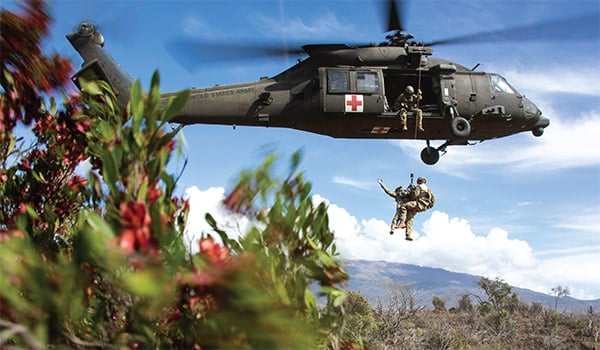
Combat Readiness Center / By COL Jason L. Miller: Army units are moving rapidly to fully implement the training required to prepare for large-scale combat operations (LSCO) against a peer or near-peer competitor.
This training will focus on the tactics necessary to rapidly deploy, execute combined arms maneuver, and succeed in a complex, multi-domain environment. One of the primary challenges is training Soldiers who have been fighting counterinsurgency (COIN) for over a decade to refocus their efforts to fight against a threat which requires them to fly at terrain flight and nap-of-the-earth altitudes. As our branch chief put it, “We are now driving closer to the curb at 100 mph.” While this flight envelope may be new for many, aviation’s fundamental principles of risk management, crew coordination, and “fly the aircraft” are critical to the success of this mission.

Soldiers with the 25th Combat Aviation Brigade and 2nd Squadron, 14th Cavalry Regiment, 2nd Infantry Brigade Combat Team, 25th Infantry Division conduct hoist MEDEVAC training during a fire support coordination exercise Nov. 19, 2019 at Pohakuloa Training Area on the Island of Hawaii./ U.S. ARMY PHOTO BY SGT THOMAS CALVERT
R-COP
Army aviation’s Risk-Common Operational Picture (R-COP) has been designed and integrated into the force in order to standardize processes and reduce risk. The R-COP is a contract between leadership and aircrews that confirms how they will execute the mission and mitigate risk to the force. Approval of the R-COP is not the end of the risk management process, but rather the point where mitigation measures are put into practical application. These mitigation measures must be incorporated into aircrew briefings and constantly discussed and reassessed with dynamic risk management throughout the mission. As the terrain, environment, and mission complexity changes, it is incumbent on aircrews to also reevaluate their mitigation measures to ensure they are within the intent of mission command and the R-COP contract.
Crew Coordination
As our flight altitude decreases and we focus on fighting against a threat which relies on radio frequency and infrared (IR) thick area of operations, our crew coordination efforts must increase. It’s no surprise that flying closer to the curb brings new hazards, whether natural or manmade, into our mission profile. Furthermore, our closure and time for reaction are reduced. To mitigate this risk, aircrews must increase their crew coordination, more specifically their effective communication in the cockpit. For aircrews that might not have the experience to understand what this means, if you want to see an excellent example of crew coordination, look at the in-car footage for rally car racers. The speeds and proximity to hazards in which they operate requires constant and effective communication between the driver and navigator to stay ahead of the car and the race. It is a practiced and choreographed example of effective communications. Aircrews, too, must utilize this same type of crew coordination mentality for effective communication. Aviators all remember Bernoulli’s principle. Well, this is the Bernoulli’s principle of crew coordination and as altitude decreases, crew coordination/effective communication must increase to stay ahead of the aircraft and the mission.
Fly the Aircraft
As aviation continues to execute tough, realistic training, and aircrews utilize terrain altitudes and methods beyond just technology to evade threats, contingencies play a critical role in this environment. Knowing EPs and limits is a vital part of proficiency; but if there is one thing that aircrews should have ingrained into their DNA, and reinforce through daily training, it is to always “fly the aircraft.” A thorough understanding of what is truly important, the implementation of hasty dynamic risk analysis, and the practice of sound judgment at terrain flight altitudes is essential. These must be practiced, both in simulated and live realistic mission training, to build competence in the force and allow aircrews to know what it truly means to “fly the aircraft.”
Conclusion
Aviation is driving closer to the curb at 100 mph. However, if Army aviation vigorously applies the fundamentals of risk management, crew coordination, and to “fly the aircraft,” we will be successful. The mission and our most precious assets, our Soldiers, depend on it.
COL Jason L. Miller is the deputy commander of the U.S. Army Combat Readiness Center at Fort Rucker, AL.







